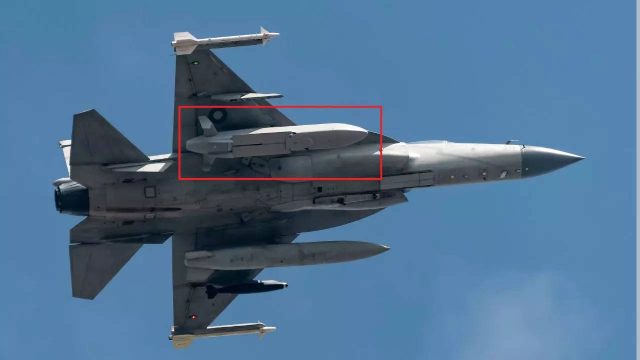A recent image captured during rehearsals for the 2023 Pakistan Day Parade has shed light on the potential nuclear capabilities of Pakistan’s JF-17 Thunder Block II aircraft. The photograph depicts a JF-17 carrying what appears to be a Ra’ad air-launched cruise missile (ALCM), marking the first public observation of this configuration.
Analyzing images of a JF-17 Thunder Block II from the 2023 Pakistan Day Parade rehearsals, the Federation of American Scientists (FAS) confirmed that the fighter jet was equipped with a Ra’ad-I nuclear missile.”Notably, this was the first time such a configuration had been observed in public,” the FAS said in its report.
To determine the specific type of Ra’ad missile in the image, comparisons were made with Ra’ad-I and Ra’ad-II missiles displayed in previous Pakistan Day Parades. While the Ra’ad-II, first unveiled in 2017, was presented as having nearly double the range capability of the Ra’ad-I, external features did not clearly distinguish the two versions until 2022. The latest Ra’ad-II, displayed in 2022 and 2024, features a distinct ‘x-shaped’ tail fin configuration, while the missile photographed on the JF-17 more closely resembles the ‘twin-tail’ configuration of the Ra’ad-I, the FAS report said.
Using Photoshop’s Vanishing Point feature and reference measurements from the vehicles carrying the missiles, the lengths of the Ra’ad-I and Ra’ad-II were estimated to be around 4.9 meters each. The missile on the JF-17 was also measured using the aircraft’s length as a reference, resulting in a similar 4.9-meter estimate. These measurements, along with the tail fin configuration, suggest that the missile observed on the JF-17 is likely the Ra’ad-I ALCM rather than the newer Ra’ad-II or the conventional anti-ship variant, Taimoor, the FAS report by Eliana Johns said.
The image provides evidence that Pakistan has made significant progress in equipping its JF-17s with the capability to supplement or replace the nuclear strike role of the ageing Mirage III/Vs. However, questions remain about the deployment status of the Ra’ad systems and whether Pakistan will continue to retain a nuclear gravity bomb capability or transition to stand-off cruise missiles exclusively.
These developments occur amidst an ongoing nuclear arms competition in the region, with Pakistan, India, and China pursuing advanced technologies such as multiple independently targetable re-entry vehicles (MIRVs). The heightened tensions and the development of short-range, lower-yield nuclear-capable systems by Pakistan have raised concerns about accelerated arms racing and escalation risks in a potential conflict between India and Pakistan.
Analyzing images of a JF-17 Thunder Block II from the 2023 Pakistan Day Parade rehearsals, the Federation of American Scientists (FAS) confirmed that the fighter jet was equipped with a Ra’ad-I nuclear missile.”Notably, this was the first time such a configuration had been observed in public,” the FAS said in its report.
To determine the specific type of Ra’ad missile in the image, comparisons were made with Ra’ad-I and Ra’ad-II missiles displayed in previous Pakistan Day Parades. While the Ra’ad-II, first unveiled in 2017, was presented as having nearly double the range capability of the Ra’ad-I, external features did not clearly distinguish the two versions until 2022. The latest Ra’ad-II, displayed in 2022 and 2024, features a distinct ‘x-shaped’ tail fin configuration, while the missile photographed on the JF-17 more closely resembles the ‘twin-tail’ configuration of the Ra’ad-I, the FAS report said.
Using Photoshop’s Vanishing Point feature and reference measurements from the vehicles carrying the missiles, the lengths of the Ra’ad-I and Ra’ad-II were estimated to be around 4.9 meters each. The missile on the JF-17 was also measured using the aircraft’s length as a reference, resulting in a similar 4.9-meter estimate. These measurements, along with the tail fin configuration, suggest that the missile observed on the JF-17 is likely the Ra’ad-I ALCM rather than the newer Ra’ad-II or the conventional anti-ship variant, Taimoor, the FAS report by Eliana Johns said.
The image provides evidence that Pakistan has made significant progress in equipping its JF-17s with the capability to supplement or replace the nuclear strike role of the ageing Mirage III/Vs. However, questions remain about the deployment status of the Ra’ad systems and whether Pakistan will continue to retain a nuclear gravity bomb capability or transition to stand-off cruise missiles exclusively.
These developments occur amidst an ongoing nuclear arms competition in the region, with Pakistan, India, and China pursuing advanced technologies such as multiple independently targetable re-entry vehicles (MIRVs). The heightened tensions and the development of short-range, lower-yield nuclear-capable systems by Pakistan have raised concerns about accelerated arms racing and escalation risks in a potential conflict between India and Pakistan.





